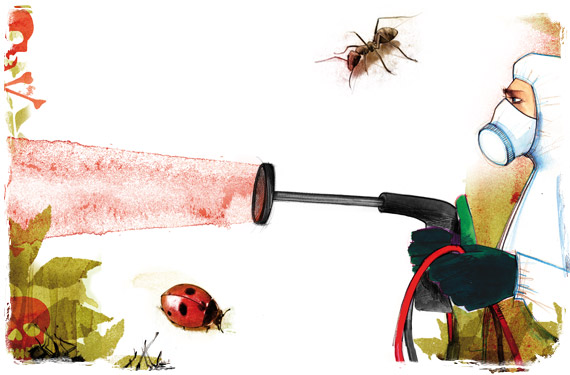Not known Details About Eco Bed Bug Exterminators Dc
Eco Bed Bug Exterminators Dc - Questions
Table of ContentsEco Bed Bug Exterminators Dc Things To Know Before You BuySome Known Incorrect Statements About Eco Bed Bug Exterminators Dc All about Eco Bed Bug Exterminators DcEco Bed Bug Exterminators Dc Things To Know Before You Get ThisThe 10-Second Trick For Eco Bed Bug Exterminators Dc
Since chemicals are harmful, they are additionally potentially dangerous to people, pets, other organisms, and the environment. Consequently, individuals that make use of pesticides or routinely come in contact with them need to recognize the family member toxicity, potential wellness effects, and preventative steps to decrease exposure to the products they make use of. Hazard, or threat, of making use of chemicals is the capacity for injury, or the level of risk associated with making use of a chemical under a provided set of conditions.
However, applicators can reduce or nearly eliminate direct exposure-- and hence decrease risk-- by following the tag guidelines, using individual safety apparel and tools (PPE), and taking care of the chemical effectively. For example, greater than 95 percent of all chemical direct exposures come from dermal direct exposure, mainly to the hands and lower arms. By wearing a set of unlined, chemical-resistant gloves, this sort of exposure can be almost removed.
The damaging results that happen from a solitary direct exposure by any type of path of entrance are described "severe results." The four courses of exposure are facial (skin), breathing (lungs), dental (mouth), and the eyes. Acute toxicity is established by checking out the dermal poisoning, inhalation toxicity, and dental poisoning of guinea pig.
Not known Incorrect Statements About Eco Bed Bug Exterminators Dc
Acute toxicity is measured as the quantity or focus of a toxicant-- the a.i.-- called for to eliminate 50 percent of the pets in an examination populace. This procedure is generally expressed as the LD50 (deadly dosage 50) or the LC50 (lethal focus 50). Additionally, the LD50 and LC50 values are based on a solitary dosage and are videotaped in milligrams of chemical per kilogram of body weight (mg/kg) of the guinea pig or partly per million (ppm).
The reduced the LD50 or LC50 value of a pesticide product, the higher its poisoning to people and animals. Chemicals with a high LD50 are the least harmful to humans if made use of according to the instructions on the product label. The persistent poisoning of a pesticide is figured out by subjecting examination animals to lasting exposure to the active component.
The persistent poisoning of a chemical is harder than severe poisoning to figure out with lab evaluation. Products are categorized on the basis of their loved one severe toxicity (their LD50 or LC50 values). Pesticides that are classified as highly toxic (Poisoning Group I) on the basis of either dental, dermal, or inhalation poisoning should have the signal words DANGER and POISON published in red with a head and crossbones icon prominently displayed on the front panel of the plan label.
The intense (single dose) dental LD50 for chemical products in this team ranges from a trace total up to 50 mg/kg. For example, exposure of a few declines of a material taken orally could be deadly to a 150-pound individual. Some pesticide items have simply the signal word threat, which informs you nothing regarding the severe poisoning, just that the item can cause severe eye damage or extreme skin irritability
Eco Bed Bug Exterminators Dc - An Overview
In this group, the acute oral LD50 arrays from 50 to 500 mg/kg. A teaspoon to an ounce of this material can be fatal to a 150-pound person (bed bug heat treatment). Chemical products categorized as either somewhat poisonous or reasonably safe (Toxicity visit this web-site Classifications III and IV) are required to have the signal word CAUTION on the pesticide label

All pesticide poisoning values, including the LD50, can be located on the item's Product Safety Information Sheet (MSDS) - exterminator near me. Pesticide labels and MSDS can be gotten from sellers or makes. On top of that, a lot of products also know that can be located on the Net. The symptoms of chemical poisoning can vary from a moderate skin irritation to coma and even fatality.
Due to the fact that of prospective health problems, pesticide customers and handlers have to identify the common signs and signs and symptoms of pesticide poisoning. The results, or signs, of pesticide poisoning can be extensively defined as either topical or systemic.
All About Eco Bed Bug Exterminators Dc
Dermatitis, or swelling of the skin, is approved as the most generally reported topical result linked with chemical exposure. Some individuals tend to cough, hiss, or sneeze when revealed to chemical sprays.
This sign typically subsides within a few minutes after an individual is eliminated from the exposure to the toxic irritant. However, a response to a chemical product that creates a person not only to sneeze and cough however likewise to develop severe intense breathing signs is much more likely to be a real hypersensitivity or allergy.
Systemic effects are fairly various from topical effects. They often take place away from the initial point of get in touch with as an outcome of the pesticide being absorbed right into and distributed throughout the body. Systemic impacts frequently consist of nausea, throwing up, tiredness, frustration, and digestive conditions. In advanced poisoning situations, the person may experience adjustments in heart rate, trouble breathing, convulsions, and coma, which can cause death.